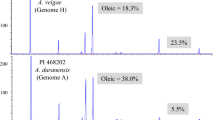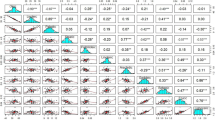Abstract
A peanut variety with high oleate content has previously been described. When this high oleate variety was used in breeding crosses, the F2 segregation ratio of high oleate to normal oleate progeny was 3:1 or 15:1 depending on the normal oleate varieties used in the crosses. These data suggested that the high oleate trait is controlled by two recessive genes, and some peanut varieties differ from the high oleate variety by mutations in one gene, while others differ by mutations in two genes. The objective of this study was to understand the molecular nature of the high oleate trait and the various segregation patterns. In the previous paper in this issue, we reported that the level of transcripts expressed by one (ahFAD2B) of two homoeologous genes for oleoyl-PC desaturases in cultivated peanut is significantly reduced in high oleate varieties. In this report, we examined gene expression by RT-PCR/restriction digestion in a cross that shows a one-gene segregation pattern for the high oleate trait. Our data showed that the severely reduced level of ahFAD2B transcript correlates absolutely with the high oleate phenotype in this cross, suggesting that the single gene difference is correlated with the ahFAD2B transcript level. When we tested the enzyme activity of the proteins encoded by ahFAD2A and ahFAD2B by expression of the cloned sequences in yeast, only the ahFAD2B gene product showed significant oleoyl-PC desaturase activity. These data, combined with the observation that ahFAD2A shows a change (D150N) in a residue that is absolutely conserved among other desaturases, raised the possibility that the ahFAD2A in these normal and high oleate lines is a mutant allele. In support of this hypothesis, we found that another ahFAD2A allele in a normal oleate peanut line does not have the D150N change. This peanut line displays a two-gene-segregation pattern for the high oleate trait. In conclusion, our results suggest that a mutation in ahFAD2A and a significant reduction in levels of the ahFAD2B transcript together cause the high oleate phenotype in peanut varieties, and that one expressed gene encoding a functional enzyme appears to be sufficient for the normal oleate phenotype.
Similar content being viewed by others
Author information
Authors and Affiliations
Additional information
Received: 8 November 1999 / Accepted: 10 March 2000
Rights and permissions
About this article
Cite this article
Jung, S., Powell, G., Moore, K. et al. The high oleate trait in the cultivated peanut [Arachis hypogaea L.]. II. Molecular basis and genetics of the trait. Mol Gen Genet 263, 806–811 (2000). https://doi.org/10.1007/s004380000243
Issue Date:
DOI: https://doi.org/10.1007/s004380000243




